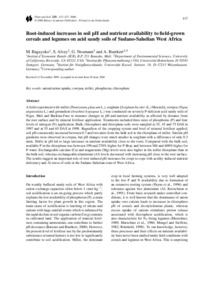| dc.date.accessioned | 2007-02-09T10:32:28Z | |
| dc.date.available | 2007-02-09T10:32:28Z | |
| dc.date.issued | 2000 | |
| dc.identifier.issn | 0032-079X | |
| dc.identifier.uri | urn:nbn:de:hebis:34-2007020917128 | |
| dc.identifier.uri | http://hdl.handle.net/123456789/2007020917128 | |
| dc.format.extent | 179761 bytes | |
| dc.format.mimetype | application/pdf | |
| dc.language.iso | eng | |
| dc.rights | Urheberrechtlich geschützt | |
| dc.rights.uri | https://rightsstatements.org/page/InC/1.0/ | |
| dc.subject | anion/cation uptake | eng |
| dc.subject | cowpea | eng |
| dc.subject | millet | eng |
| dc.subject | phosphorus | eng |
| dc.subject | rhizosphere | eng |
| dc.subject.ddc | 630 | |
| dc.title | Root-induced increases in soil pH and nutrient availability to field-grown cereals and legumes on acid sandy soils of Sudano-Sahelian West Africa | eng |
| dc.type | Aufsatz | |
| dcterms.abstract | A field experiment with millet (Pennisetum glaucum L.), sorghum [Sorghum bicolor (L.) Moench], cowpea (Vigna unguiculata L.) and groundnut (Arachnis hypogeae L.) was conducted on severely P-deficient acid sandy soils of Niger, Mali and Burkina Faso to measure changes in pH and nutrient availability as affected by distance from
the root surface and by mineral fertiliser application. Treatments included three rates of phosphorus (P) and four levels of nitrogen (N) application. Bulk, rhizosphere and rhizoplane soils were sampled at 35, 45 and 75 DAS in 1997 and at 55 and 65 DAS in 1998. Regardless of the cropping system and level of mineral fertiliser applied, soil pH consistently increased between 0.7 and two units from the bulk soil to the rhizoplane of millet. Similar pH gradients were observed in cowpea, but pH changes were much smaller in sorghum with a difference of only 0.3 units. Shifts in pH led to large increases in nutrient availability close to the roots. Compared with the bulk soil, available P in the rhizoplane was between 190 and 270% higher for P-Bray and between 360 and 600% higher for P-water. Exchangeable calcium (Ca) and magnesium (Mg) levels were also higher in the millet rhizoplane than in the bulk soil, whereas exchangeable aluminium (Al) levels decreased with increasing pH close to the root surface. The results suggest an important role of root-induced pH increases for crops to cope with acidity-induced nutrient deficiency and Al stress of soils in the Sudano-Sahelian zone of West Africa. | eng |
| dcterms.accessRights | open access | |
| dcterms.bibliographicCitation | In: Plant and Soil. Dordrecht : Kluwer. 225.2000, H. 1, S. 117-128 | |
| dcterms.creator | Bagayoko, M. | |
| dcterms.creator | Alvey, S. | |
| dcterms.creator | Neumann, G. | |
| dcterms.creator | Bürkert, Andreas | |
| dc.description.everything | The original publication is available at www.springerlink.com | eng |
| dc.subject.swd | Westafrika | ger |
| dc.subject.swd | Augenbohne | ger |
| dc.subject.swd | Perlhirse | ger |
| dc.subject.swd | Phosphatdüngung | ger |
| dc.subject.swd | Rhizosphäre | ger |

